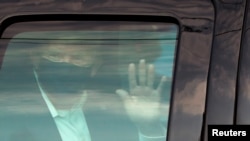After tweeting a video early Sunday evening saying he’s “getting great reports” from his doctors, U.S. President Donald Trump promised a little surprise for his supporters outside the hospital where he is being treated for COVID-19.
The president then briefly left Walter Reed National Military Medical Center in an armored SUV with Secret Service agents in tow to drive by a flag-waving, cheering crowd outside the hospital.
“President Trump took a short, last-minute motorcade ride to wave to his supporters outside and has now returned to the Presidential Suite inside Walter Reed,” White House spokesman Judd Deere said in a statement.
Earlier Sunday, the doctors treating the president revealed that their patient experienced “two episodes of transient drops in his oxygen saturation.”
Despite that, “The fact of the matter is, he is doing really well,” the president’s primary physician, Dr. Sean Conley, told reporters. COVID-19 is the disease caused by the coronavirus.
A team led by Conley was more transparent during Sunday’s news briefing than the previous day, when their appearance before a pool of White House reporters seemed to raise as many questions as it answered.
Conley, asked by a reporter why he had been evasive on the question of whether Trump had required supplemental oxygen at the White House on Friday — which the president did for about an hour — replied he was trying “to reflect the upbeat attitude of the team.”
Conley, an osteopath and a commander in the U.S. Navy, explained that he did not “want to give any information that might steer the course of illness in another direction and in doing so it came off that we were trying to hide something, which wasn’t necessarily true.”
That medical team, during a 10-minute briefing on Sunday outside the front steps of the Walter Reed, explained that the president is now taking a steroid, dexamethasone, which is typically not administered in mild or moderate cases of the coronavirus, along with a five-day course of remdesivir, an antiviral medication.
Dr. Sean Dooley, an Army colonel and pulmonologist, told reporters that the president’s vital signs were stable on Sunday morning and the patient was walking around, not complaining of shortness of breath or experiencing any other respiratory symptoms.
“If he continues to look and feel as well as he does today, our hope is that we can plan for a discharge as early as tomorrow to the White House, where he can continue his treatment course,” announced Dr. Brian Garibaldi, a civilian specialist in pulmonary and critical care medicine at Johns Hopkins University School of Medicine.
Some key questions remain, such as whether the president has suffered any lung damage. Doctors in their responses Sunday declined to go beyond saying there have been the “expected findings” with their patient, who is a 74-year-old overweight male.
Trump on Friday had a high fever, and that — along with the brief need for supplemental oxygen — prompted the president’s move from the White House to the hospital, according to Conley.
Trump tweeted a video Saturday evening in which he said he was doing well and hoped to be back soon, acknowledging that the next few days will be the “real test.”
Conley received word Thursday evening that both Trump and first lady Melania Trump tested positive for the coronavirus after one of the president’s close aides, Hope Hicks, was confirmed to be ill with the infection.
The president’s decision to do a drive-around for supporters Sunday evening was condemned by one attending physician at Walter Reed as irresponsible.
Dr. James Phillips, who is also chief of disaster medicine at George Washington University in Washington, tweeted that the special vehicle the president was riding in is sealed against chemical attack.
“The risk of COVID19 transmission inside is as high as it gets outside of medical procedures. The irresponsibility is astounding. My thoughts are with the Secret Service forced to play,” said Phillips, referring to the driver and an accompanying agent in the front seat who appeared to be wearing masks, face shields and gowns.
“Appropriate precautions were taken in the execution of this movement to protect the president and all those supporting it, including PPE,” Deere, the White House spokesman said. “The movement was cleared by the medical team as safe to do.”
Earlier Sunday, National Security Adviser Robert O’Brien said there had not been a discussion of temporarily transferring power to Vice President Mike Pence.
“We have a government that is steady,” O’Brien said on CBS News’ Face the Nation, adding later, “We have plans for everything.”
Trump’s campaign Friday put on hold all previously announced events involving the president’s participation. Pence is to make campaign appearances this week, as well as face off Wednesday evening against the Democrats’ vice presidential nominee, U.S. Senator Kamala Harris of California.
Sunday marked 30 days before the Nov. 3 presidential election. Trump’s
opponent, former Vice President Joe Biden, said Friday he was sending “prayers for the health and safety of the first lady and the president of the United States.”
Biden added that the president’s positive test is a “bracing reminder to all of us that we have to take this virus seriously.”
Trump and Biden were about 4 meters apart on a debate stage Tuesday evening in Cleveland, Ohio. The U.S. Centers for Disease Control and Prevention suggests at least 2 meters for social distancing purposes.
Biden’s campaign said the former vice president tested negative Friday for the coronavirus and a test on Sunday was also negative.
Speaking Friday in Grand Rapids, Michigan, Biden, wearing a surgical mask, called again for a national mask mandate, asserting it could save 100,000 lives in 100 days.
The coronavirus has killed nearly 210,000 people in the United States and infected about 7.4 million across the country, according to Johns Hopkins University data.










